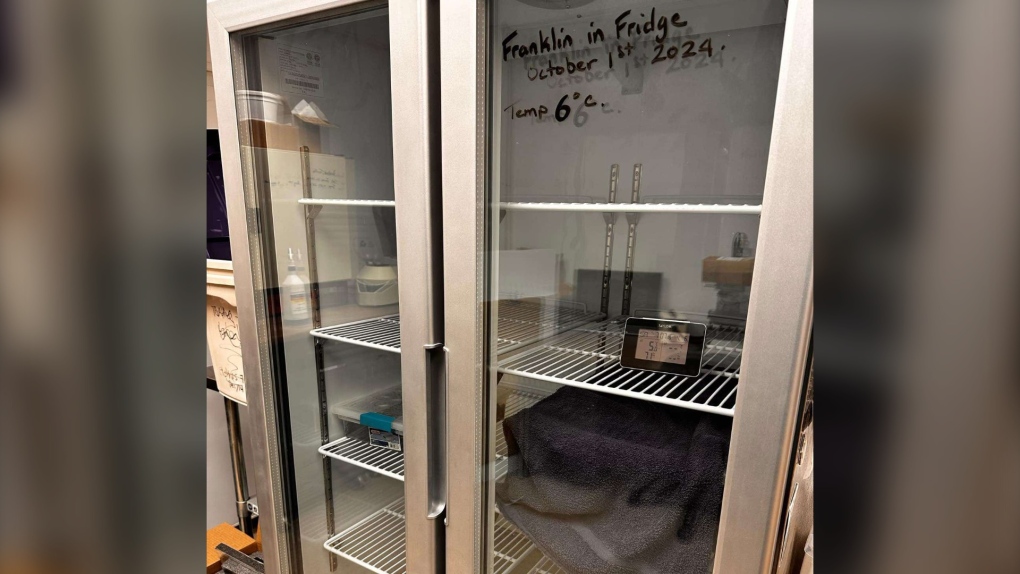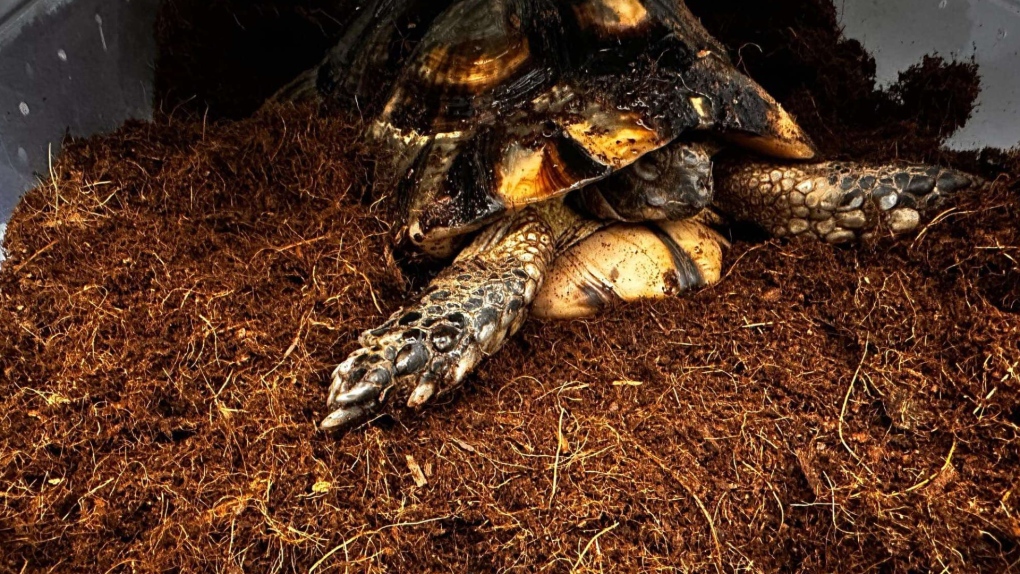Meet Franklin, the rescued tortoise who spent the last three months in a B.C. fridge
 Franklin, a marginated tortoise, is shown in this photo provided by the B.C. Wildlife Park.
Franklin, a marginated tortoise, is shown in this photo provided by the B.C. Wildlife Park.
Franklin the tortoise has been in a fridge for the past 15 weeks.
The rescued reptile is in the care of the B.C. Wildlife Park, where he was taken after he was found on the shores of Shuswap Lake in the province’s Interior.
“Presumably he was abandoned by somebody and let loose, because he definitely was not supposed to be out there,” animal keeper Dylan Tracey said.
Franklin – a marginated tortoise native to high-altitude parts of the Mediterranean – requires specific conditions to make it through the winter months and could never have survived outdoors in this climate.
In their natural habitat, tortoises like Franklin go into a state called brumation, which Tracey describes as “similar to hibernation, but not true hibernation,” once temperatures dip below 10 C.
 The fridge where Franklin underwent brumation is shown in this photo provided by the B.C. Wildlife Park.
The fridge where Franklin underwent brumation is shown in this photo provided by the B.C. Wildlife Park.
As the external temperature drops, so too does the tortoise’s internal temperature – as well as its metabolism. While a tortoise in this state requires little-to-no food to survive, it also doesn’t move much or quickly, making it vulnerable to predators.
“They have adapted and evolved this behavior to last out the winter,” Tracey said.
“They will seek out an animal burrow or they will excavate their own in the hillside because the temperature tends to be more stable underground. And then they'll kind of half bury themselves and they will just wait until it warms up again.”
Franklin spent the summer in an outdoor enclosure at the wildlife park but on Oct. 1, he was moved into the fridge in order to undergo brumation.
“The fridge is really the best way to do it because you can control the temperature a lot better,” Tracey said, explaining that it’s important to hit a “sweet spot” of around 5 or 6 C because if temperature gets too low it is fatal, and if it’s too high Franklin’s metabolism will speed up and he’ll burn through his fat stores.
 Photo provided by B.C. Wildlife Park
Photo provided by B.C. Wildlife Park
Franklin will come out of the fridge this week, and will stay indoors until it is warm enough to return him to his outdoor enclosure.
The B.C. Wildlife Park shared Franklin’s story last month to remind people that it’s crucial to understand what an exotic pet like a marginated tortoise needs before bringing one home.
Tortoises – in particular – are a big commitment, Tracey said, noting their long lifespans.
“Most tortoises can live over 100 years. So, it's a big time investment,” he said.
While members of Franklin’s species don’t grow as large as some others, they do end up weighing over ten pounds and measuring over a foot long and require a fair bit of space in which to comfortably move around.
“It's quite sad, but it's all too common with reptiles. People will get them when they're very small, they're usually very cute – especially tortoises, they’re extremely cute. But people will get them not really imagining or thinking much about how much of an investment it is,” Tracey said.
The wildlife park urges anyone who finds themselves unable to care for an exotic pet to reach out to an animal welfare organization or other experts to get advice on how to proceed rather than abandoning the animal outdoors.
CTVNews.ca Top Stories

'Hell on earth': Ottawa rapper TwoTiime among Canadians displaced by L.A. fires
Ottawa rapper Khalid Omar, who performs under the name TwoTiime, was forced to evacuate his Calabasas condo as wildfires tore through the Los Angeles area this week, leaving the studio where he records in ruins.
16 dead, 16 missing as fire crews try to corral Los Angeles blazes before winds return this week
The death toll from the wildfires ravaging the Los Angeles area rose to 16 as crews battled to cut off the spreading blazes before potentially strong winds return that could push the flames toward some of the city's most famous landmarks.
Alberta premier Danielle Smith meets with Trump at impromptu Mar-a-Lago visit
Alberta premier Danielle Smith met with President-elect Donald Trump Saturday at Mar-a-Lago in Florida.
Are there U.S. military bases and American troops in Canada?
The U.S. military has more than 165,000 troops deployed in over 170 countries and territories, including Canada.
Costco Canada accused of overcharging online shoppers in class-action lawsuit
Perrier Attorneys says Costco charged more for items online than in-store, a practice known as “double ticketing,” which is banned under the Competition Act.
Meet Franklin, the rescued tortoise who spent the last three months in a B.C. fridge
Franklin the tortoise has been in a fridge for the past 15 weeks.
Teen's road test halted by stunt driving charge
A 17-year-old driver failed their road test before it even began after being stopped by police in a community safety zone.
'He was a genius': Family remembers man who died waiting for care in Winnipeg ER
The sister of a man who died waiting for care in the emergency department of Winnipeg’s Health Sciences Centre (HSC) is remembering her late brother as an intelligent person with a bold personality
Former PM Chretien says Liberal party must move back to 'radical centre'
As the Liberal party searches for a new leader, former prime minister Jean Chretien says it's time for the party to move back to the "radical centre" to help its electoral fortunes.
































